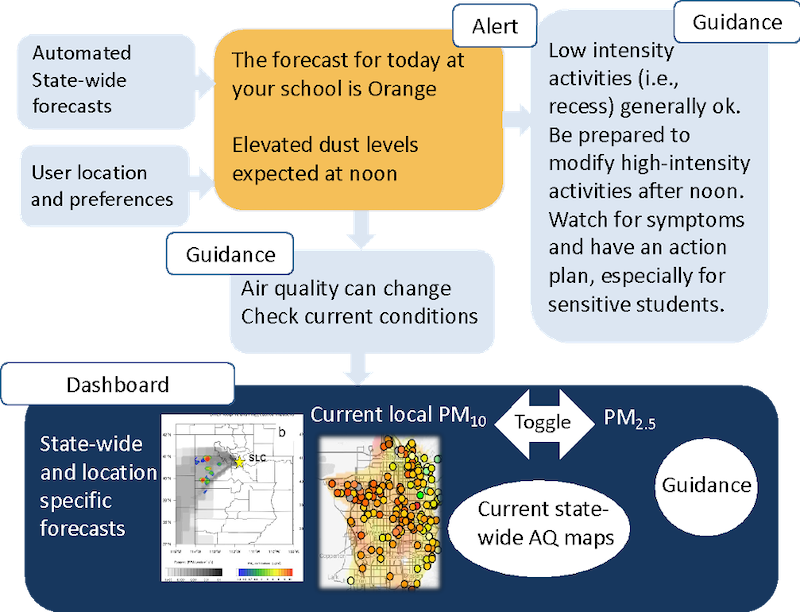About CREATE AQI
More than 40% of Americans — over 137 million people — live in areas with unhealthy levels of outdoor air pollution. Communities with poor air quality are predominantly found in the Western US and in historically underserved areas. Children and student-athletes are vulnerable to elevated air pollution levels because their lungs are not fully developed, and they have more rapid breathing rates, particularly when engaging in athletic activities. Current air quality forecasts and measurements fail to protect children and student-athletes from critical air quality hazards, in particular, dust and wildfire smoke. Utah exemplifies air quality challenges in the Western US, where both urban and rural communities experience poor air quality events caused by wildfire smoke and wind-blown dust events, but the severity and geospatial extent of these events is unknown. State-run monitoring stations are sparse, and many rural counties have no regulatory measurements. Seventeen of Utah’s 29 counties do not have any regulatory measurements or air quality forecasts. For counties with forecasts, the forecasts have low spatial resolution, are for a 24-hour period, are limited to ozone and fine particulate matter (PM2.5), do not include dust, and do not account for the spatial variability of pollution. In addition, Utah’s current forecasting framework is not automated and requires input from expert staff. Furthermore, because of Utah’s complex terrain, local air-quality forecasts and air-quality maps provided by federal agencies can be inaccurate because they are designed for the entire continental U.S.

Our project, Community Resilience through Engaging, Actionable, Timely, high-rEsolution Air Quality Information (CREATE-AQI), is co-developing (with children’s health decision makers and key governing agencies, see our Team) location-specific, actionable air quality information to help reduce exposure to air pollutant hazards, particularly for children. CREATE-AQI builds on the team’s existing air-quality sensing and forecasting infrastructure as well as strong civic partnerships to co-develop and evaluate the necessary measurements, forecasting tools, effective message-delivery strategies, and quality metrics to protect children and communities from air-quality hazards. CREATE-AQI expands on the University of Utah’s existing air quality sensing infrastructure by adding new sensing capabilities for dust, by generally extending the geographic coverage of the network, and by placing sensors on athletic fields and in childcare facilities. CREATE-AQI will integrate existing meteorological, dust transport, wildfire smoke transport, and air-quality forecasting models to automatically generate high spatial resolution air quality forecasts.
This video shows the Yellow Lake Fire and its effect on Wasatch, Summit, Weber, Davis, and Salt Lake Counties.
We are working on the following novel developments:
- High-resolution (4-km horizontal resolution, hourly) automated numerical forecasts of air pollution hazards, specifically for inversions, wildfire smoke, ozone, and dust, for the state of Utah, including both urban and rural communities
- Integration of a new, cost-effective air quality sensor into an existing community air quality network (AQ&U that measures PM2.5, particulate matter 2.5 um in diameter and smaller) to understand dust (PM10, particulate matter 10 um in diameter and smaller) levels (including the development of the necessary modeling and data visualizations)
- Understanding the most effective way to craft and deliver actionable, science-based messages about potential air quality hazards for decision-makers
- Determining if children who remain indoors during school activities are experiencing healthy levels of air quality (i.e., that meet indoor air quality guidelines)
Project Focus Areas
The project entails three core research areas.
-
Air Quality Guidance
Air quality guidance targeted to protect children and student-athletes from the impacts of poor air quality.
Read more... -
Air Quality Measurements
A network of low-cost air-quality sensors measure air pollutants, with measurements rendered on an air pollutant heat map in real-time.
Read more... -
Air Quality Forecasts
Daily forecasts to provide information about potential air pollution risks during scheduled outdoor activities for children and student athletes.
Read more...